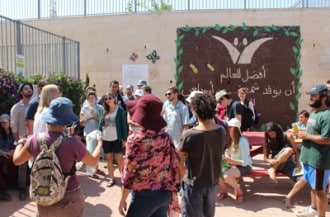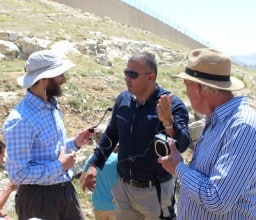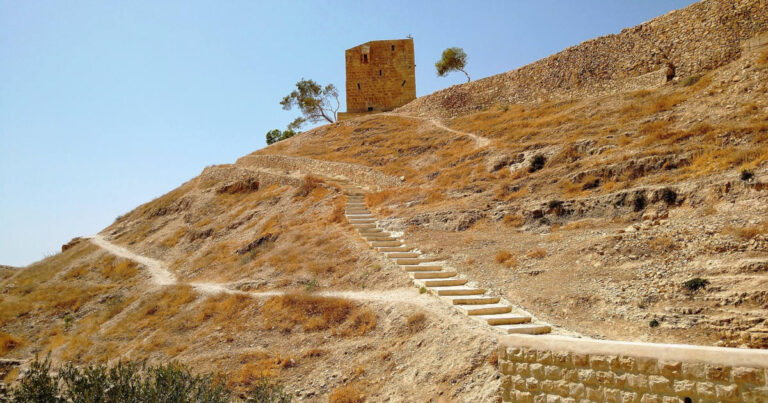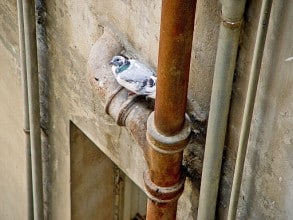By Ricki Silber
The Interfaith Center for Sustainable Development co-organized and co-guided a tour of the Kidron Valley, together with the renowned Israeli guide Avner Goren, for 40 Jordanian, Israeli, Palestinian, and international students of the Arava Institute of Environmental Studies.
The tour took place on April 30th, 2015, and began at the Haas Promenade, with a stunning view of the Kidron Valley (Wadi el Nar in Arabic)), including the Old City of Jerusalem and golden Dome of the Rock. At the base of the Old City lies the Gihon Spring, which has provided year-round fresh water to inhabitants of this city for millenia. The students then walked in an urban nature area shared by Arabs and Jewish residents of Jerusalem.
Next, the group traveled to the Afak school in the Arab neighborhood of Tsur Baher. Within the Kidron Valley basin, the school is a steller grassroots environmental initiative. The school has a unique educational approach for children with learning disabilities. The school focuses on involving students in ecological projects,- including greenhouse, aquaponics and an herb garden.
The Afak school educates on the symbiotic relationship between the students and their environment. The hands-on projects have improved the students concentration in their work, and decreased behavioral issues, and better atmosphere for them to flourish in. The students have become more mindful of their environment and day to day effect on the planet. The education has spread to increased gardens and compost in the communities and homes of the students.
The last stop of the tour was in the Arab neighborhood of Jabel el Mukaber. Today, the smell has made life difficult for some of the close to 100,000 people who live there. The creek has become a flowing sewage system carrying human waste from Jerusalem until it spills into the Dead Sea.
The Kidron seasonal stream flows from the Old City of Jerusalem from both eastern and western sides. On its way to the Dead Sea, it goes through parts of the Palestinian Authority, passing stunning regions both natural and archeological. The 33 kilometer creek passes heritage and cultural sights from all three monotheistic religions.
Not only is the water being polluted, the entire ecosystem of the area has been disrupted and damaged. The sewage is a contamination risk to all the surrounding plants and animals. Every year one billion birds pass through the Kidron Valley on their migration route– 500 million in the spring, and 500 million in the fall. Storks and cranes can be seen drinking human waste, yet Expecting natural spring water. The people who live along suffer as well, from the horrid smell as well as the mosquitos it attracts, preventing them from opening windows and using the creek in a normal fashion.
Although Israel is at the forefront wastewater reuse, with wastewater treatment plans for Tel Aviv, Western Jerusalem, and elsewhere. Yet the situation with the Kidron represents a wasted opportunity to reuse water that is scarce in the region.
So what can we do to help? For the people of Jerusalem how can we bridge the gap between the mindfulness of God and the mindlessness of our treatment towards the land? How can we keep the holiest city of ours clean, and pure?
These questions are begged to be asked when the land, the same land that is esteemed to be holy, is being degraded. “We can envision this becoming a Garden of Eden” exclaimed Naim, a resident of Jabel Al Mukaber, an Arab village in which the creek runs through, on his optimism.
Inspired by the Afak school, we too would like to create a symbiotic relationship between Jerusalem’s residents and her land. By redirecting our waste, we can restore the creek and its surrounding ecosystem. In return we can have a more enjoyable and beautiful Jerusalem. The residents of Abu Al Mukaber can be relieved from the smell as well as benefiting from water to be used for their agriculture, and a beautiful nature reserve running past our holy sights. The people of The Holy Land and her people will mutually benefit from this.
Several plans have been made to build a waste water treatment plant, but none have materialized. The Kidron Valley Master Plan was created by a committee created from members of the Palestinian Water Authority, the Israel Water Authority, Engineers Without Borders, and representatives from the U.S. State Department and Israel Ministry of Foreign Affairs. There is a joint effort now to clean the Kidron, the first step, they stated in their meeting is to lay a sewage pipe from Jerusalem to Ubadia. May this lead to a cleaner Jerusalem for all of its residents!
Photos by Chelsea Revell
* Featured image source








